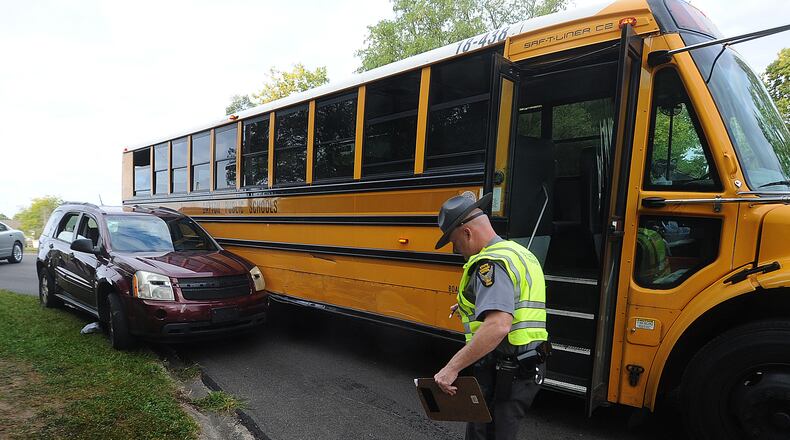In Ohio, 800,000 students ride the bus every school year. In Lebanon, the district’s buses travel 1 million miles. Seevers delivered those statistics Oct. 13 while standing in the district’s transportation center, where there were more than 85 buses.
The superintendent hosted officials from the Ohio State Highway Patrol and other Warren County police agencies for the news conference conducted ahead of National School Bus Safety Week. The message was this: “Children are our No. 1 priority.”
That was the sentiment from Seevers and from Tyler Ross, a sergeant with the Ohio State Highway Patrol. Ross said officials will be highly visible in school zones next week. They will also follow some buses on their routes to ensure other drivers stop when required to.
“You’re’ driving a weapon,” Ross said. “We have to take this seriously.”
But while safety was the topic of the day, none of the speakers addressed seat belts on school buses.
Credit: Keith BieryGolick/Staff
Credit: Keith BieryGolick/Staff
On the first day of school in August, an 11-year-old Clark County boy died after he was ejected from his bus in a crash near Springfield. On that day, a minivan drove into oncoming traffic, according to officials. The school bus driver on the other side of the road attempted to avoid the van by driving onto the shoulder, but they still collided.
The bus went off the side of the road, rolling to its side. Dozens of other children were hurt.
Only nine states require seat belts on school buses, and Ohio is not one of them. Many safety organizations, like the National Transportation Safety Board, and parent groups, like the Ohio and National PTA boards, recommend seat belts on school buses.
After the deadly crash, Ohio Gov. Mike DeWine formed a group to study school bus safety, including seat belts. The group met on Thursday and heard testimony from a superintendent near Cleveland who piloted a seat belt program in her district for two years.
She said she wouldn’t recommend it.
According to media reports, the superintendent said younger students struggled to get seat belts buckled and older students didn’t fit. She also said drivers have to pull over on the side of the road if there are issues with seat belts.
National Highway Traffic Safety Administration crash data previously examined by the Journal-News Pulse shows school buses are among the safest vehicles on the road, with less than 1% of all traffic fatalities involving children on school transportation vehicles. Nationally, most of the people killed in school-transportation-related crashes were occupants of other vehicles.
After the press conference in Lebanon, Superintendent Seevers said there is conflicting data on whether seat belts make buses safer. He noted some of the district’s younger students and students with disabilities wear seat belts.
“In the event of an emergency,” he said, “one of the concerns about seat belts would be how quickly do you get those kids off the bus?”
Ross declined to take a position on seat belts in school buses. He said districts do have the option to require them if they want.
“We don’t write the laws, we just enforce them,” Ross said.
Samantha Wildow contributed to this report.
About the Author

